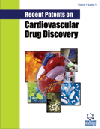Recent Patents on Cardiovascular Drug Discovery (Discontinued) - Current Issue
Volume 10, Issue 1, 2015
-
-
Hypertension in Type 2 Diabetes Mellitus: Do We Need to Redefine the Role of Sulfonylureas?
More LessAuthors: Devindra Sehra and Sudhish SehraBackground: Within a few years of diagnosis, patients with Type 2 Diabetes Mellitus (T2DM) develop hypertension. It has been hypothesized that both are part of metabolic syndrome. However, studies on diabetic patients have been undertaken while they are on treatment for diabetes. Thus, the results of these studies and inference drawn thereon may not be due to the diabetic process per se but may also be due to the medi Read More
-
-
-
Basic and Clinical Research Against Advanced Glycation End Products (AGEs): New Compounds to Tackle Cardiovascular Disease and Diabetic Complications
More LessAuthors: Antonio Nenna, Cristiano Spadaccio, Mario Lusini, Luca Ulianich, Massimo Chello and Francesco NappiDiabetes is a major risk factor for cardiovascular disease, and recent advances in research indicate that a detailed understanding of the pathophysiology of its effects is mandatory to reduce diabetes-related mortality and morbidity. Advanced Glycation End Products (AGEs) play a central role in the genesis and progression of complications of both type 1 and type 2 diabetes mellitus, and have been found to be imp Read More
-
-
-
The Challenges of Blood Pressure Control in Dialysis Patients
More LessAuthors: Vito M. Campese and Ravi LakdawalaHypertension is very prevalent among patients with chronic kidney disease (CKD) and end-stage kidney disease (ESRD). However, there are still several unsolved issues pertaining to the definition, variability, diagnosis and management of hypertension in these patients. This manuscript critically reviews the current challenges in clinical practice in defining, diagnosing and treating hypertension in CKD and ESRD patients. Read More
-
-
-
NOAC or warfarin for Atrial Fibrillation: does time in therapeutic range matter?
More LessAuthors: Ioannis Merinopoulos, Paul Venables, Isobel Chalmers and Vassilios VassiliouAtrial fibrillation (AF) is the commonest cardiac arrhythmia currently affecting 1-2% of the general population, with stroke being one of its most fearsome complications. Dose-adjusted warfarin is an established treatment for reduction of thromboembolic risk but mandates dietary restrictions and need for routine blood monitoring. Novel oral anticoagulants have recently been introduced that might provide at least equal reduct Read More
-
-
-
Combination of Vasopressin –Epinephrine as a Novel Candidate in Patients with Cardiac Arrest
More LessObjectives: Out-hospital Cardiac arrest is considered as a global disease, which causes high rate of morbidity and mortality. Although, the return of spontaneous circulation occurs in 10 to 60 percent of cases in OHCA, with variety of treatment, the most patients faced with multiple organ failure and ultimately death. The investigations demonstrated that endogenous vasopressin levels in patients with successful resuscitation is m Read More
-
-
-
Cardiovascular Implantable Electronic Device Infections: Risk Scoring and Role of Antibiotic Envelope in Prevention
More LessAuthors: Nasir Shariff, Tauseef Akthar, Eathar Razak, Nathan Segerson and David SchwartzmanCardiac implantable electronic device (CIED) has been increasingly used with expanding indications in patients with cardiac diseases. There is substantial evidence to suggest of their role in improving outcomes in patients with and without heart failure. Complications of the device implantation including infections are associated with increased morbidity and mortality and also substantial financial burden to the socie Read More
-
Most Read This Month Most Read RSS feed
Article
content/journals/prc
Journal
10
5
false
en


